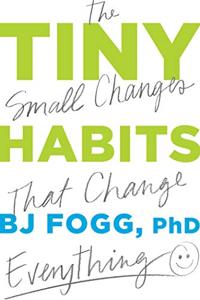
Want to learn the ideas in Tiny Habits better than ever? Read the world’s #1 book summary of Tiny Habits by BJ Fogg Ph.D here.
Read a brief 1-Page Summary or watch video summaries curated by our expert team. Note: this book guide is not affiliated with or endorsed by the publisher or author, and we always encourage you to purchase and read the full book.
Video Summaries of Tiny Habits
We’ve scoured the Internet for the very best videos on Tiny Habits, from high-quality videos summaries to interviews or commentary by BJ Fogg Ph.D.
1-Page Summary of Tiny Habits
Overview
Every year, millions of people resolve to make changes in their lives. They want to eat healthier, exercise more, and get more sleep. For a time, they work out and improve their eating habits. However, after some weeks go by these new habits start slipping away until they’re back to square one again. Why is it so hard for them to maintain these new behaviors?
Stanford behavioral expert BJ Fogg believes that we take on too much at once when trying to change our behavior. So instead of doing a grueling 2-hour workout for the first day, try something like 10 minutes of exercise daily. The problem with this approach is that it’s hard to sustain and often leads us to give up before we achieve success. In these key points, you’ll learn about how tiny habits can help you make small changes in your life without overwhelming yourself or feeling guilty if you don’t succeed right away. You’ll also learn why motivation and willpower alone aren’t enough to guarantee success; how prompts can both help and hurt your cause; and why it’s so important to anchor new behaviors into existing routines.
Big Idea #1: Creating positive change can be easy, but it requires a new approach.
There are many people who want to make changes in life. Some of them strive to lead healthier lives and get in shape, while others focus on becoming more productive or finding outlets for their creativity. However, the stream of media reports on rising obesity levels, sleeplessness, and job dissatisfaction suggests that something is wrong. This indicates a gap between what we want to do and what we actually do. Typically, we believe this disconnect is due to a lack of willpower on our part. But that’s not true because there are hidden factors at play here—factors which prevent us from doing all the things we want to do but don’t accomplish successfully enough.
So, the key to creating positive change is that it’s easy if you use a new approach. If you’ve ever failed at introducing a positive habit into your life, there’s a good chance you blamed yourself because of lack of discipline and motivation.
People assume that motivation is the key to change, but there’s little evidence to support this idea. This means that the real culprit isn’t you – it’s your approach to change. For example, if you try assembling a flat-pack chest of drawers from IKEA and find that the instructions are wrong or pieces are missing, then you’ll fail. It will be frustrating, but of course you won’t blame yourself. No–you’ll call IKEA and demand a refund because their instructions were wrong and parts were missing in your package. However when it comes to self-improvement, we let ourselves off the hook by assuming our failure was due to lack of motivation instead of flawed approaches.
The problem with that is, it’s not working. What should we do instead? We need to try a different approach.
First of all, stop blaming yourself if you have a hard time changing. It’s not your fault because years of advice has been unscientific and ineffective. The reason is simple: behavior change can be easy when you understand how human behavior actually works. We’ll cover that in this article as well as some key points on how to make it happen for you.
First, you need to identify your goals. You can do that by breaking down the big goal into manageable steps. This will help you achieve your goals and it’s a sustainable approach. The author has used this method with thousands of people through her Stanford Behavior Design Lab research and studies over the years.
Okay – let’s begin!





